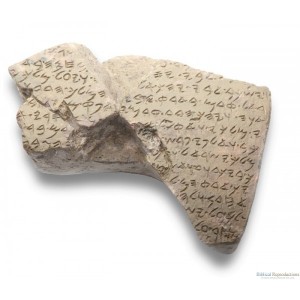Finding writing at all is unusual in Biblical archaeology. Finding a piece of such enormous historical importance as “The House of David” inscription was truly an earth-shaking discovery. But it was not the only piece of writing found at the city of Dan.
A piece of limestone measuring 25.6 cm (about 10 inches) in width, 18.2 cm (about 7 inches) in height, and 3.2 cm (about 1¼ inches) in thickness — a little smaller than the size of a regular sheet of writing paper –was discovered near the temple area of the ancient city in 1976 by the excavation team of the Hebrew Union College. On it was a 4-line inscription. 3 lines were written in Greek and the fourth was in Hebrew.
The Greek text is a dedication to “the God who is in Dan,” or alternatively “to the God of the Danites”. The last line, in Hebrew, tells us that Zoilos made a vow. The Greek text is clear and eminently readable, a sign that it was carved by a professional stone carver. The last line in Hebrew is irregular, and broken off in any case, and was presumably written by Zoilos himself and copied onto the stone by someone else. We are surprised that we do not know the name of the god referred to, and we do not know just what Zoilos had vowed to do. But we do learn that Dan was a popular and busy holy place because there was a professional stone cutter in attendance there, filling out votive plaques for the many pilgrims who came. And we know that Zoilos, whoever he was, was a Jew (despite having a Greek name) because he wrote in Hebrew. But our information more or less ends here.
The unique significance of this find is not in the god or in Zoilos, but that, for the only time in the history of Biblical archaeology, we have found an actual contemporary evidence of what this place was called in ancient times. Consider the fact that there are dozens of places in Israel mentioned in the Bible (e.g. Gilgal, see Josh 4:19) whose actual location has never been determined. At many more places (e.g. Qumran, place of the Dead Sea Scrolls), we have a place but have no idea what the ancients called it. Most other Biblical cities — Megiddo,Akko, Shechem, etc. — are reasonably assumed by scholars to be where the sites are today. And some others (e.g. Gath of Goliath) are more or less confirmed but still in dispute among scholars.
But none of them has what Dan has: a sign identifying the place from ancient times found right there on site. “To the God who is in Dan;” it’s like finding a sign that says “Rotary Club of Tel Dan, meets on Thursday afternoon!”
An exquisite reproduction of the House of David inscription is available at www.biblical reproductions.com Biblical Reproductions is licensed by the Israel Antiquities Authority.
Author: Walter Zanger

